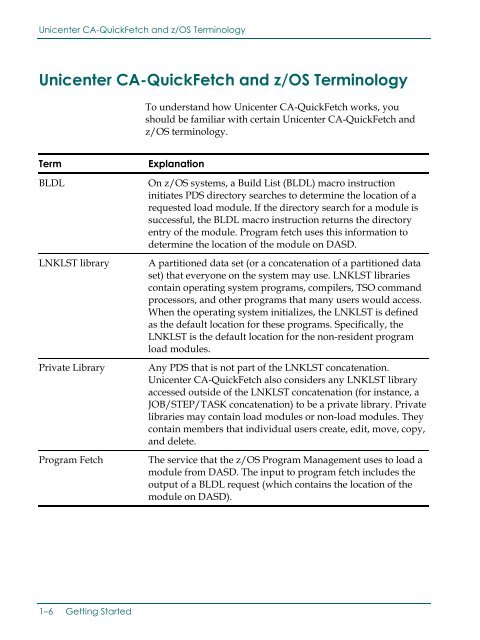Unicenter CA-QuickFetch Getting Started
Unicenter CA-QuickFetch Getting Started
Unicenter CA-QuickFetch Getting Started
Create successful ePaper yourself
Turn your PDF publications into a flip-book with our unique Google optimized e-Paper software.
<strong>Unicenter</strong> <strong>CA</strong>-<strong>QuickFetch</strong> and z/OS Terminology<strong>Unicenter</strong> <strong>CA</strong>-<strong>QuickFetch</strong> and z/OS TerminologyTo understand how <strong>Unicenter</strong> <strong>CA</strong>-<strong>QuickFetch</strong> works, youshould be familiar with certain <strong>Unicenter</strong> <strong>CA</strong>-<strong>QuickFetch</strong> andz/OS terminology.TermBLDLLNKLST libraryPrivate LibraryProgram FetchExplanationOn z/OS systems, a Build List (BLDL) macro instructioninitiates PDS directory searches to determine the location of arequested load module. If the directory search for a module issuccessful, the BLDL macro instruction returns the directoryentry of the module. Program fetch uses this information todetermine the location of the module on DASD.A partitioned data set (or a concatenation of a partitioned dataset) that everyone on the system may use. LNKLST librariescontain operating system programs, compilers, TSO commandprocessors, and other programs that many users would access.When the operating system initializes, the LNKLST is definedas the default location for these programs. Specifically, theLNKLST is the default location for the non-resident programload modules.Any PDS that is not part of the LNKLST concatenation.<strong>Unicenter</strong> <strong>CA</strong>-<strong>QuickFetch</strong> also considers any LNKLST libraryaccessed outside of the LNKLST concatenation (for instance, aJOB/STEP/TASK concatenation) to be a private library. Privatelibraries may contain load modules or non-load modules. Theycontain members that individual users create, edit, move, copy,and delete.The service that the z/OS Program Management uses to load amodule from DASD. The input to program fetch includes theoutput of a BLDL request (which contains the location of themodule on DASD).1–6 <strong>Getting</strong> <strong>Started</strong>
















